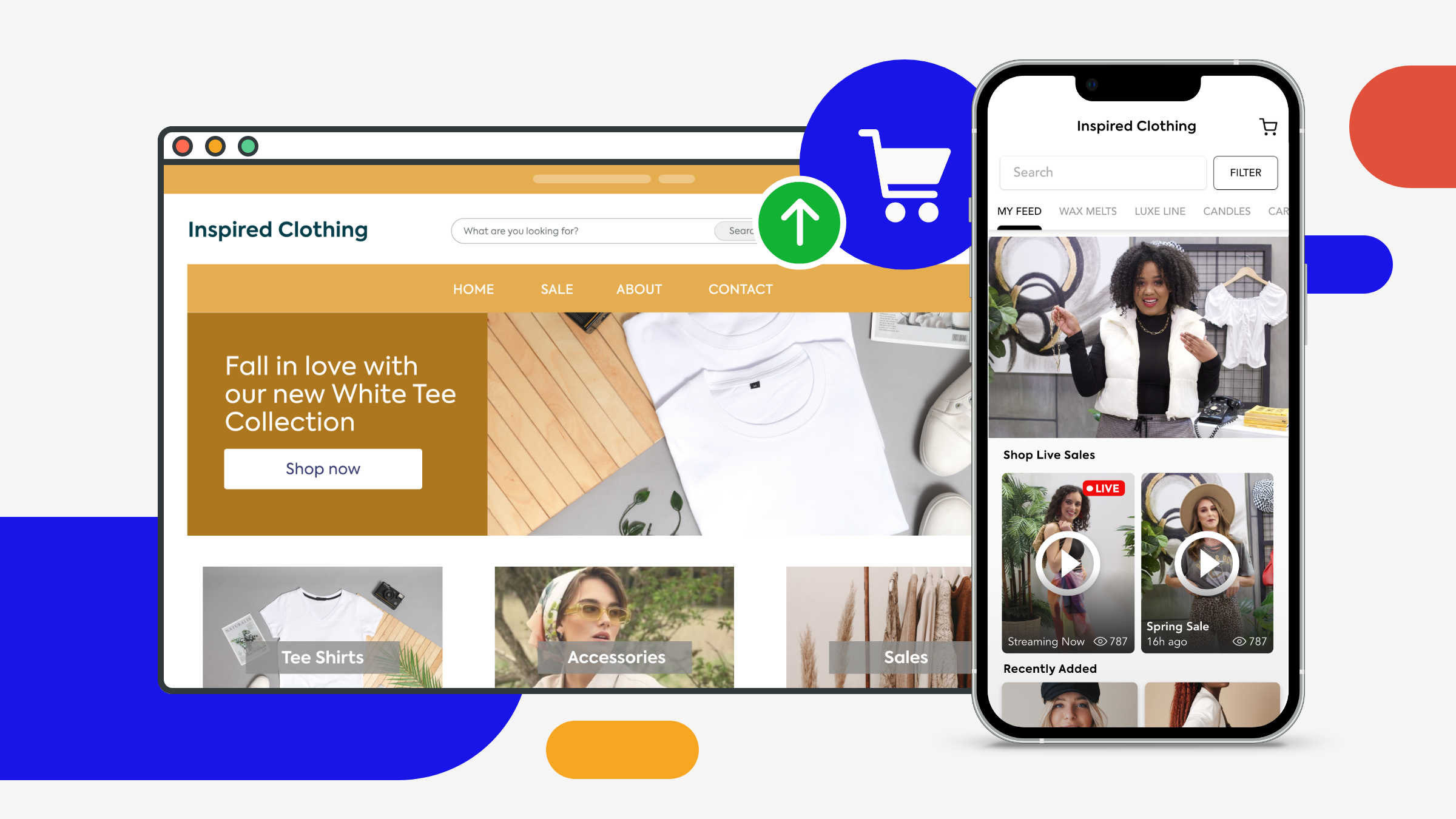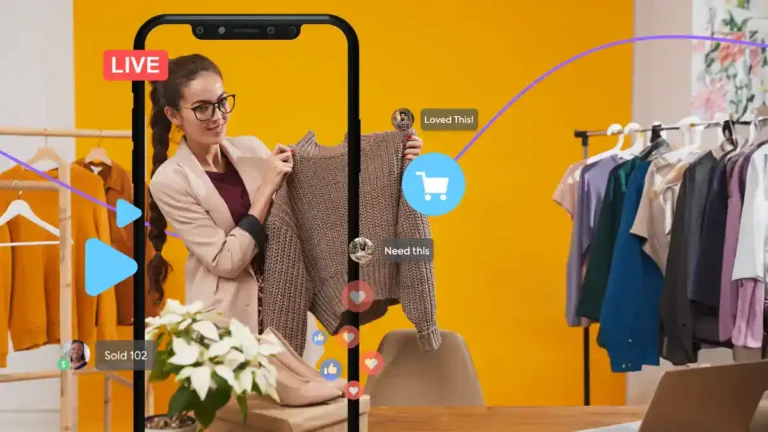The world has become increasingly digital, with mobile devices serving as essential tools that connect consumers with the products, services, and people they want and need. With the tap of an app or a voice-activated search via virtual assistant, mobile device users can get the information they’re seeking in seconds.
Consumer demand for fast, convenient, and well-designed virtual experiences is on the rise, and now is the time for businesses to adjust. While there is certainly value in doing things the “old-school” way, today’s brands simply have to embrace the digital way of life if they want to stay in business.
Retail brands, in particular, can marry physical storefronts with virtual storefronts with more ease than ever before. Considering e-commerce will account for 22% of global retail sales by 2023, when it comes to how to start an e-commerce business, finding the best solution to sell online is essential. Much thought, care, and consideration are put into finding the right location, space, and décor for a brick-and-mortar store. This same attention to detail should be at the forefront when weighing options for various online selling platforms.
Find What Works for Your Brand
Some retailers find massive success selling products on social media, while others thrive by launching their own mobile apps. What’s right for one brand may not work for another, depending on their audience demographics and behaviors or the way their online home looks and functions. Many of today’s sellers are looking for the easiest online selling solution so they can get up and running (and start making sales) as fast as possible.
If this is the case for your brand, choosing an all-in-one e-commerce platform that allows you to sell across multiple channels is ideal. Aside from ease of use on the back end, another consideration is how well you can reach more customers and connect with more shoppers using your chosen selling avenue. There are many factors to consider when deciding which is the best solution to sell online, so let’s dig into them.
What is an Online Selling Platform?
There are hundreds of places online where producers can sell goods to consumers and set up their own online stores. Some may choose to sell exclusively on social media, while others might hire a web developer and list products for sale only on their websites. Each online selling platform has its own unique requirements, audiences, product categories, seller fees, and costs.
So, what is an online selling platform anyway? An e-commerce platform is generally a website where a seller can sign up and begin loading in their products to sell via an online storefront. These online selling platforms include shipping tools, inventory management, payment processing, and other elements for facilitating transactions. This is what sets it apart from a standard website.
Sellers can still sell products on a very basic website, however, if they have integrations or processes in place to make actual sales this way. Some smaller sellers may decide the best platform to sell online is a marketplace like Amazon, Etsy, or eBay, rather than their own branded website. Using this type of e-commerce platform allows any type of seller to reach a mass, anonymous audience who may be searching for a specific product without the desire to buy from a particular shop or brand.
Weighing Your Options
If connecting with shoppers and building lasting customer relationships is important to your business, choosing online selling platforms that build brand recognition and customer loyalty may be more valuable to your business. This is where a fully customized online storefront and retail mobile app could be considered the best platforms to sell online compared to a larger online “shopping mall” where your brand can get lost in the mix.
When weighing your options as a business owner for places to sell online, consider these factors:
- Am I manufacturing the products myself or buying them wholesale from a vendor?
- Do I have the budget to open my own, fully branded online shop?
- Do I only have one or a few of each item for sale?
- Is it important to stand out online using innovative strategies like live selling or social media influencers?
Your brand, business model, and product offerings will all factor into where you choose to sell online. For example, a vintage shop that carries only one or two antique pieces may have more success on an auction marketplace like eBay, rather than creating an entire product page on Amazon only for the page to be removed once the item has sold out.
Going Multichannel
The beauty of e-commerce in the digital age is that brands don’t have to pin down just one sales channel online. They can opt for the easiest online selling method to push products quickly, while still selling on other online storefronts to reach different audiences where they’re already spending time and browsing products online.
Social media platforms like Facebook, Instagram, and TikTok now have their own built-in checkout options, making it easier for brands to sell products directly on their social pages. Followers can view a photo or video and buy the product almost instantly, without having to click a link that directs them away from the post. It’s a good idea for brands to still have a fully branded “home” online and utilize other third-party platforms as additional selling channels rather than relying on one hosted platform to complete all of their sales transactions.
Benefits of Selling on Online Platforms
The biggest advantage of having a home on the web is being able to reach potential customers around the clock, no matter where they’re located. Launching a brick-and-mortar retail store is a lot of hard work, and finding enough staff, resources, and local customers to keep it running is certainly a challenge for any entrepreneur.
The beauty of selling online is that virtually anyone can get started with minimal cost commitment. At the minimum, all you need are products, photos, a plan for shipping, a way for customers to pay, and—of course—a place online to make the transactions happen.
Additional benefits of selling online platforms include:
- Getting your brand and store up and running quickly
- Using established marketplaces or social media platforms to reach an existing audience of consumers
- The ability to reach new (and more) people outside of your local community
- Little overhead or warehouse space is needed if you’re utilizing a program like drop shipping
- Integrating sales and marketing quickly and easily through online photos, videos, and captions
- Easy ways to communicate with shoppers and address questions fast
Launching an online store comes with several considerations aside from choosing the best solution to sell online. If you’re just starting out, ask yourself the following questions:
- How much do I want to spend to list my products and maintain my online store?
- Do I want to design my online store myself or hire outside help?
- How will I integrate with other selling channels, using multichannel consistency, to expand my reach?
- Who do I need to hire to get products listed, packed, and shipped out on time?
- What do my marketing and advertising strategies look like?
- What payment options will I offer to my online shoppers, and how will I integrate these payment gateways into my store?
- How will I manage my inventory counts, orders, shipping, fulfillment, returns, and exchanges?
This list of considerations will not only help you put together the beginnings of a solid business plan, it will also help you determine which online selling solution is right for your brand, your capacity, your customer, and the goals you’re looking to achieve.
Best Platforms to Sell Your Products Online
Your Own Website
Having your own online storefront helps people remember your brand and guides them to one place where they can find information and products about your business. A strong e-commerce website will contain products organized into categories, contact information, a compelling “about us” page, and ordering information at the minimum.
Shipping times and details, return and exchange information, professional product photography, shoppable videos, and reviews are all bonus offerings that consumers not only appreciate but also seek out from today’s retailers. Owning your own website allows you to provide these details to visitors in a central location that’s branded to your business.
With your own e-commerce website, you can utilize marketing tools to drive organic traffic to yourself, and with a catchy domain name, you can plaster your URL all over your ads and promotional materials so shoppers know exactly where you live online.
Your Own Mobile App
Considering that U.S. adults spend an average of 3.47 hours in mobile apps each day, compared to just 23 minutes in their web browser, and the fact that mobile apps are expected to generate over $935 billion in revenue by 2023, retail apps are becoming a prime way to sell products in the e-commerce space.
Much like a website, sellers can create an entire brand presence on a branded mobile app. Because the app lives on shoppers’ home screens, products are within reach at all times. Retailers can enable push notifications, which alert users about upcoming sales, new products, and special promotions to get them shopping with a particular brand more often.
E-commerce sees a 278% lift in engagement when push notifications are enabled, and mobile app users typically opt in for push notifications 52% of the time. Keeping your brand and products in your customers’ pockets is a successful way to reach them anytime, anywhere.
Amazon
Amazon is the largest of the online marketplaces and dominates online retail sales in the United States, and the site is expected to account for almost half of the eCommerce market in 2022. With perks like Prime, which offers fast, free shipping to its 76+ million members, it’s no secret that Amazon has set a precedent for today’s shoppers. For users who value speed, convenience, and the power to choose above all else, using Amazon to find a product they need is preferable.
However, smaller businesses can still thrive on the giant Amazon marketplace by using it as one of their online selling platforms. Since today’s shoppers have become accustomed to having multiple ways to shop with brands, offering Amazon as one option is just smart business. But if you really want to make your brand stand out, you’ll want to have a fully branded home elsewhere on the web and social media.
Amazon is one of the top online selling platforms because of its sheer number of users and the trust it has built among shoppers who use it frequently. However, because big brands are likely listing products similar to yours in larger quantities, succeeding as a smaller business on the Amazon marketplace can pose some challenges.
Etsy
Makers and entrepreneurs thrive on Etsy because it’s an e-commerce marketplace for handmade goods and other unique, often one-of-a-kind items. Compared to Amazon, where big brands often dominate, Etsy is where smaller businesses can truly shine. Etsy is one of the best online selling solutions for independent shops because it offers built-in sales tools and analytics so you can learn how to increase e-commerce sales, and millions of shoppers are already browsing the site.
Brands still face competition on Etsy, however, and standing out from competitors will require thoughtful and clever marketing, professional photos, positive customer reviews, and carefully crafted product listings. Etsy can be a great transitional tool for makers who sell their goods in person at farmers’ markets or other vendor events, but for those who want to be in complete control of their online stores, this type of marketplace isn’t fully customizable.
eBay
A name that’s become synonymous with online auctions since 1995, eBay has come a long way from simply a tool for individuals to get rid of old baseball cards or Beanie Babies for the highest bidder. Brands are utilizing eBay’s “Buy It Now” option to sell their products at a fixed price to consumers. Many consider eBay to be one of the easiest online selling platforms if they just want to get products out to the masses. Little is required in the way of setting up an entire store, or even a brand, on eBay.
The online marketplace does instate seller and listing fees, but they are relatively low. eBay has a Global Shipping Program, where sellers can have a marketplace warehouse pick, pack, and ship inventory on their behalf, which cuts out a significant amount of labor and shipping costs.
In the past few years, the largest social media platform has changed from a place to connect with family and friends and find out what’s going on in the area to a very profitable way for businesses to market and advertise. Merchants also have the ability to set up their Facebook shop and sell directly on the social network through Facebook Marketplace, as well as on Facebook Live with the right ecommerce tools in place.
Smaller businesses are thriving on Facebook because of the ability to build communities through brand pages and private groups. Like-minded individuals with similar tastes, budgets, or spending habits can join together to follow and interact with a brand on a platform they’re likely already familiar with and active on. Brands can integrate their marketing and sales efforts on social media with ease.
Primarily used as a photo and video-sharing platform, Instagram is unique because consumers can go through the entire buyer’s journey on a single app. From the discovery of a product to checking out right on the platform, shopping on Instagram is simple and intuitive. Instagram is especially lucrative for brands in the fashion and home decor spaces because they can draw in new followers through aesthetically pleasing visuals.
Stories, reels, static posts, and carousels offer the opportunity for retailers to get creative on the platform and attract millennial shoppers with spending power. Instagram Shopping has taken off in recent years, showing the social media platform’s support of and interest in elevating brands that use its app.
TikTok
A bit of a newcomer in the online selling space, TikTok has rapidly exploded in popularity—particularly among Gen Z audiences. The app has put creators in the spotlight and has become a hub for new trends and memes that bleed into everyday life outside of a screen. Brands are taking their organic marketing efforts to new heights by creating videos that educate and amuse audiences around the world.
Retailers can use TikTok for online selling by setting up a business account on the app and using the TikTok Shopping feature to tag videos with their products. They can also tap into the influencer community and hire popular creators to hype up their brands in videos and direct viewers to the brand’s e-commerce store or mobile app by speaking directly with their followers on TikTok.
Chairish
Perhaps the most niche among the online selling platforms, Chairish is perfect for brick-and-mortar vintage or antique shops that want to sell larger items online, like furniture, without the hassle of shipping and other logistics. Sellers can list their products for free, and curators will approve items that appeal to audiences.
The platform also fixes up product photos and checks out buyers, giving busy home décor merchants “white-glove” service. There are some drawbacks, however. Chairish works on a consignment model, so while sellers do get paid 70% or more of their listing price, the site does keep up to 30% of the cost.
Shoppers can also view one seller’s entire offerings, but the product pages aren’t fully branded. There are various selling models to each shop, however, so Chairish is still a great option in a multichannel selling strategy for vintage and home decor brands specifically.
CommentSold
Retailers that are looking for the easiest online selling platform that streamlines their inventory management, orders, web and social media presence, and customer communications can sign up for CommentSold to run their entire online business from one online dashboard.
CommentSold facilitates selling across a brand’s Facebook and Instagram accounts and provides tools to create a fully functional e-commerce store and even a branded mobile app. Shops can use live video to sell directly to their shoppers across their preferred selling channels or all selling channels at the same time. If you’re looking for the best solution to sell online to multiple audiences at the same time, you can start loading your products and hosting your first live sale through CommentSold today.
Essential Steps for Online Marketplace Success
Building out your e-commerce presence online should be viewed as a marathon, not a sprint. Over time, you will determine what’s working and areas that could be improved. As your company grows online, you’ll likely be able to add more members to your team who can lend their marketing, sales, and technical expertise to your home on the web.
If you’re just starting out and need a few tips to set up your online retail business, follow these steps as you begin:
Build Out Your Inventory
Before you launch your online store, the first step is determining which products you’re going to sell. Will you be making everything in-house, or will you purchase items from wholesalers? How many size and color options will you offer? Are you selling to a certain type of customer, or do your products have more widespread appeal? What are the best products to sell online?
Decide on your “niche” and build out your product selection from there. Your products should align with your brand’s values, messaging, and image. For example, if your company is all about sustainability and serving the local community, your products should be ethically sourced or developed. If your brand is all about body positivity and inclusivity, make sure you have a wide range of sizes and shapes for all types of consumers.
Create Compelling Product Listings
There’s a difference between products people browse and what they actually buy. The advantage of shopping in person is that consumers can try on items, feel them, and get a good look at them in real life to decide if they want to purchase them. Online, sellers are typically limited to static product photos and text that describes each item.
This is where strong sellers excel. Use high-quality photography that clearly shows your item, and offer additional photos that highlight a real person using, wearing, or interacting with the item. Beautiful set designs, lighting, props, and backdrops can all aid in the visual appeal of your product photography.
Better yet, include video with your product listings that show exactly how an item looks when it is used by a real person. This is where live video selling can take your product listings to new heights! Viewers can see real people using the product, much like they would in a physical store.
Add detail to your text that accompanies your visuals, including size information, measurements, material, ingredients, and suggested uses. Utilize keywords in your listings to help shoppers find your products while searching for similar items online.
Price Items Appropriately and Provide Payment Options
You can browse competitor brands and products to gain an understanding of your inventory’s market value. Also consider how much you spent to either source your product or purchase materials to manufacture it, and factor in labor, shipping and handling fees, packaging, web hosting costs, ad spend, and how much profit you want to make.
There are many different factors that go into pricing your products. If you want to offload aging inventory, consider offering discounts on those items or bundling high and low-priced items together in a set. Offer your shoppers multiple ways to pay so you can reduce abandoned shopping carts by providing a variety of payment options.
Make Checkout Seamless
If you’re selling on an e-commerce marketplace like Amazon, eBay, or Etsy, you’re at the mercy of the platform’s built-in checkout tools. Fortunately, these companies have the bandwidth to continually refine the checkout process for your customers. If you’re using your own website, app, or social media accounts to list and sell your products, make sure the checkout process is fast, easy, and doesn’t deter shoppers from completing their purchases.
Cart abandonment costs e-commerce merchants to lose more than $18 billion a year, and 18% of adults said a long or complicated checkout process causes them to abandon their carts. Some ways to keep checkout smooth: require the minimum information needed, like name, address, and credit card information; and keep pop-ups or other distractions off of your checkout page so shoppers don’t get distracted and exit their carts.
If your online selling platform allows shoppers to save their shipping and payment information, or create an account that securely saves their details, turn that option on! The easier it is for people to check out using their preferred payment method, the more sales you will make.
Keep the Connection Going
Thank your shoppers and offer them an incentive to keep buying with you. When they complete a purchase, send an email or show a “thank you” page with a coupon code or offer for the next time they shop with your brand. Make sure to follow up promptly with shipping details, and keep customers in the loop about their order as things move along or change.
As you collect information about your shoppers, consider opting them in to marketing campaigns where they receive emails and/or text alerts when you have new product drops or discounts in your e-commerce store. Encourage shoppers to follow you on social media for exclusive sneak peeks of new items or to get a discount on their next order.
Always go above and beyond to make shopping in your e-commerce space a fun, delightful, and pleasant experience that will keep shoppers coming back. Loyal customers mean repeat shoppers and new business through word-of-mouth and positive testimonials about your brand. Keep this going by addressing your customers directly through the use of a live selling platform or using marketing automation tactics that keep you in touch with them around the clock.
The Takeaway
You’ve got products, a strong brand voice, and a strategy in place to make sales and revenue. There’s a lot to consider when deciding which is the best solutions to sell online. Think about your niche and what is realistic for your online business at this stage. We always recommend offering the ability to sell to your shoppers in as many places as possible so you aren’t missing out on potential sales. However, a multichannel selling strategy requires a central location where you can keep all aspects of your business managed and organized.
Try, CommentSold, the leader in e-commerce platforms for live selling today.



